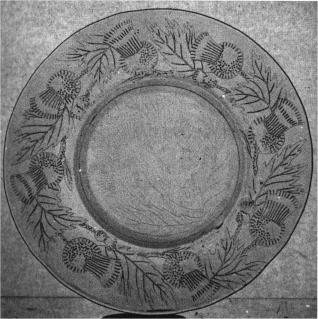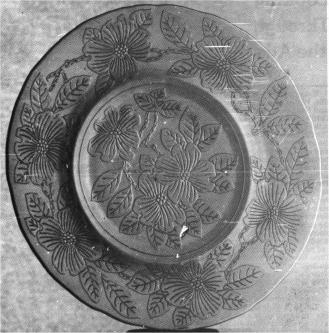National Depression Glass Association
Preserving America's Glass Manufacturing Heritage
Dogwood and Thistle
by Glenita Stearns
Glass Review - October 1981
 Macbeth-Evans Glass Company introduced both DOGWOOD and the THISTLE
patterns in l929. A cursory glance at the two patterns reveals their
common parentage, but Dogwood must have been the most popular. Thistle
was discontinued in 1930, but Dogwood stayed in the line until 1932.
Both are found in pink and green, though a few pieces of each show up
in yellow and crystal. I know one woman who broke one of her four
crystal Thistle 5½" crystal bowls ten years ago and still has
been unable to replace it. Dogwood shows up occasionally in Monax and
Cremax, colors more often associated with Petalware and American
Sweetheart also introduced by Macbeth-Evans in 1930.
Macbeth-Evans Glass Company introduced both DOGWOOD and the THISTLE
patterns in l929. A cursory glance at the two patterns reveals their
common parentage, but Dogwood must have been the most popular. Thistle
was discontinued in 1930, but Dogwood stayed in the line until 1932.
Both are found in pink and green, though a few pieces of each show up
in yellow and crystal. I know one woman who broke one of her four
crystal Thistle 5½" crystal bowls ten years ago and still has
been unable to replace it. Dogwood shows up occasionally in Monax and
Cremax, colors more often associated with Petalware and American
Sweetheart also introduced by Macbeth-Evans in 1930.
 Unfortunately, few pieces exist in Thistle (shown at right). It is a lovely pattern
with a bit more originality than some Depression Glass patterns. All
you could hope to find would be the cereal bowl mentioned above, the
10½" large fruit bowl (which would be a bargain if less than
$70), the 8" luncheon plate, 10¼" grill plate, 13" heavy, very
thick cake plate and a cup and saucer.
Unfortunately, few pieces exist in Thistle (shown at right). It is a lovely pattern
with a bit more originality than some Depression Glass patterns. All
you could hope to find would be the cereal bowl mentioned above, the
10½" large fruit bowl (which would be a bargain if less than
$70), the 8" luncheon plate, 10¼" grill plate, 13" heavy, very
thick cake plate and a cup and saucer.
In Dogwood, (shown at left) with persistance and enough money, you will be able to complete a dinner set. Green is more difficult to find than pink, and commands a slightly higher price. There is also an 8½" berry bowl, as well as the two sizes mentioned in the Thistle pattern bowls. Plates will be found in 6", 8", 9¼" and a 10½" grill plate with the design on the border only. There is also a 12" salver and an 11' thick cake plate as well as a 13" one. These plates are heavy, with a thick solid foot. You would think none could be broken except with a hammer. Few must have been made, because they are scarce and relatively high priced. The pink Dogwood 13" example, the most common of the three, sold recently at a show for $47.
Dogwood pitchers are rare. The design was put on with a silk screen process and few are known to exist. Tumblers also were decorated in this manner, but more of them seem to have survived the years. The 12" oval platter, also rare, would bring about a third of the price of the pitcher which is advertised occasionally in the $500 range.